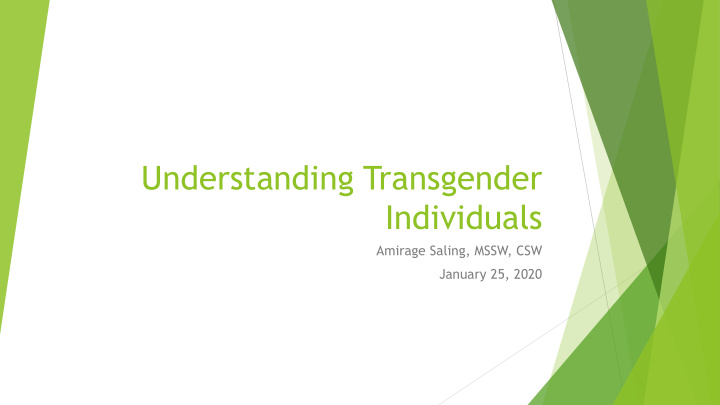



Understanding Transgender Individuals Amirage Saling, MSSW, CSW January 25, 2020
Welcome Introduction Learning Objectives Separating Gender from Genitalia Terminology Stigma Office Behavior Psychosocial Issues Questions
Amirage Saling, MSSW, CSW • Transgender • First trans banner carrier • Medical Case Manager • Advocate • Survivor of the 1990s Pronouns: She, Her, Her’ s Female Transsexual Transgender
Learning objectives 1.Better understanding of gender vs genitalia 2. Understanding Stigma 3.Able to identify ways to make your business setting less hostile to transgender people
Genitalia vs Gender vs General Popul. X(2) - (X+Y) = n SEX vs IDENTITY
By definition Transgender is an umbrella term for persons whose gender identity, gender expression or behavior does not conform to that typically associated with the sex to which they were assigned at birth. Gender identity refers to a person’s internal sense of being male, female or something else; Gender expression refers to the way a person communicates gender identity to others through behavior, clothing, hairstyles, voice or body characteristics. - American Psychological Association
Gender fluidity GENDER IDENTITY FEMALE MALE NON-BINARY GENDER EXPRESSION ANDROGYNOUS FEMININE MASCULINE SEXUAL ORIENTATION BISEXUAL STRAIGHT GAY
Transgender terminology Transgender: Transsexual: Transsexual Pre-operative Crossdressing Post-operative Drag Queens/Kings Non-operative Intersex Male-to-Female (M2F) Androgynous Female-to-Male (F2M)
Correct pronoun use
Stigma “Stigma is the social process of labeling, stereotyping, and rejecting human difference as a form of social control” ( Reisner, & Pachankis, 2015). “Stigma and discrimination experienced by transgender people have been associated with increased risk for depression, suicide, and HIV... transgender stigma and discrimination experienced in health care influence transgender people's health care access and utilization” ( Poteat, German, & Kerrigan, 2013). “Discrimination rooted in transphobia, the irrational fear, anger, hatred, disgust, and/or discomfort for individuals who do not conform to society’s gender expectations and genderism, an ideology that reinforces the negative evaluation of gender non-conformity, and the privileging of gender conformity…” (Austin & Goodman, 2017).
Stigma in the healthcare environment In one study, in understanding stigma in a healthcare environment, “Participants also described instances in which they were mocked, belittled, and otherwise verbally abused by health professionals. Name-calling, swearing, and making threats and insulting comments were among the offenses” ( Kosenko, Rintamaki, Raney & Maness, 2013). “Because transgender people are aware that most providers are not trained to meet their needs, they also approach the encounter with uncertainty about the provider's competence” ( Poteat, German & Kerrigan, 2013). “As a result of unaddressed biases and ignorance toward transgender clients, substance use disorder (SUD) counselors may unwittingly cause harm to clients rather than promote recovery” ( Oberheim, DePue & Hagedorn, 2017).
Office awareness The “NOT -SO- The “WHAT -THE- The “COME -LOOK- HAPPY-YOU-ARE- HELL-IS- THAT” AT-THIS- HERE” medical assistant EVERYONE” group receptionist The “I -AM-GOING-TO-KEEP- CALLING-YOU-BY-THE-WRONG- PRONOUN” medical provider The “LET’S - HUDDLE-IN-A- GROUP-AND- GIGGLE” gang
How trans people communicate When trans people receive treatment that is felt as unpleasant and disrespectful, we tell EVERYONE! When trans people receive treatment that is felt as pleasant and respectful, we tell EVERYONE!
Psychosocial issues Bathrooms Misgendering Bullying/harassment (physical and verbal) Suicide Murder HIV
Psychosocial issues continued
Tips for an inclusive environment ➢ Be aware of facial expressions and body language (the poker face) ➢ Smiling is infectious and welcoming ➢ Do not stare, Do not stare, (PLEASE!) Do not stare ➢ Provide gender neutral bathrooms ➢ Use correct pronouns (not sure, ask) ➢ Be knowledgeable about trans people ➢ Hire trans people
In conclusion “An equality study showed that the more than 6,450 transgender and gender-nonconforming respondents reported very high levels of postponing medical care when sick or injured due to discrimination (28%) or inability to afford care (48%) The study also found that 19% of survey participants were refused medical treatment outright.” Grant, J. M., Mottet, L., Tanis, J. E., Herman, J., Harrison, J., & Keisling, M. (2010). National transgender discrimination survey report on health and health care: Findings of a study by the National Center for Transgender Equality and the National Gay and Lesbian Task Force . National Center for Transgender Equality.
In conclusion continued “Overall, 41.8 percent of FTM participants ( N = 1,711) reported verbal harassment, physical assault, or denial of equal treatment in a doctor's office or hospital.” Shires, D. A., & Jaffee, K. (2015). Factors associated with health care discrimination experiences among a national sample of female-to-male transgender individuals. Health & social work , 40 (2), 134-141.
Questions? As a group One-on-one Email Contact information: Amirage.Saling@Louisville.edu Subject line: Trans 101 CAPTASA
Resources Austin, A., & Goodman, R. (2017). The impact of social connectedness and internalized transphobic stigma on self-esteem among transgender and gender non-conforming adults. Journal of Homosexuality, 64 (6), 825-841. Kosenko, K., Rintamaki, L., Raney, S., & Maness, K. (2013). Transgender patient perceptions of stigma in health care contexts. Medical Care, 51 (9), 819-22. Oberheim, S., DePue, M., & Hagedorn, W. (2017). Substance use disorders (suds) in transgender communities: The need for trans-competent sud counselors and facilities. Journal of Addictions & Offender Counseling, 38 (1), 33-47. Poteat, T ., German, D., & Kerrigan, D. (2013). Managing uncertainty: A grounded theory of stigma in transgender health care encounters. Social Science & Medicine (1982), 84 , 22-9. White, H., Reisner, S., & Pachankis, J. (2015). Transgender stigma and health: A critical review of stigma determinants, mechanisms, and interventions. Social Science & Medicine (1982), 147 , 222-31.
Recommend
More recommend